Physical Address
304 North Cardinal St.
Dorchester Center, MA 02124
Physical Address
304 North Cardinal St.
Dorchester Center, MA 02124
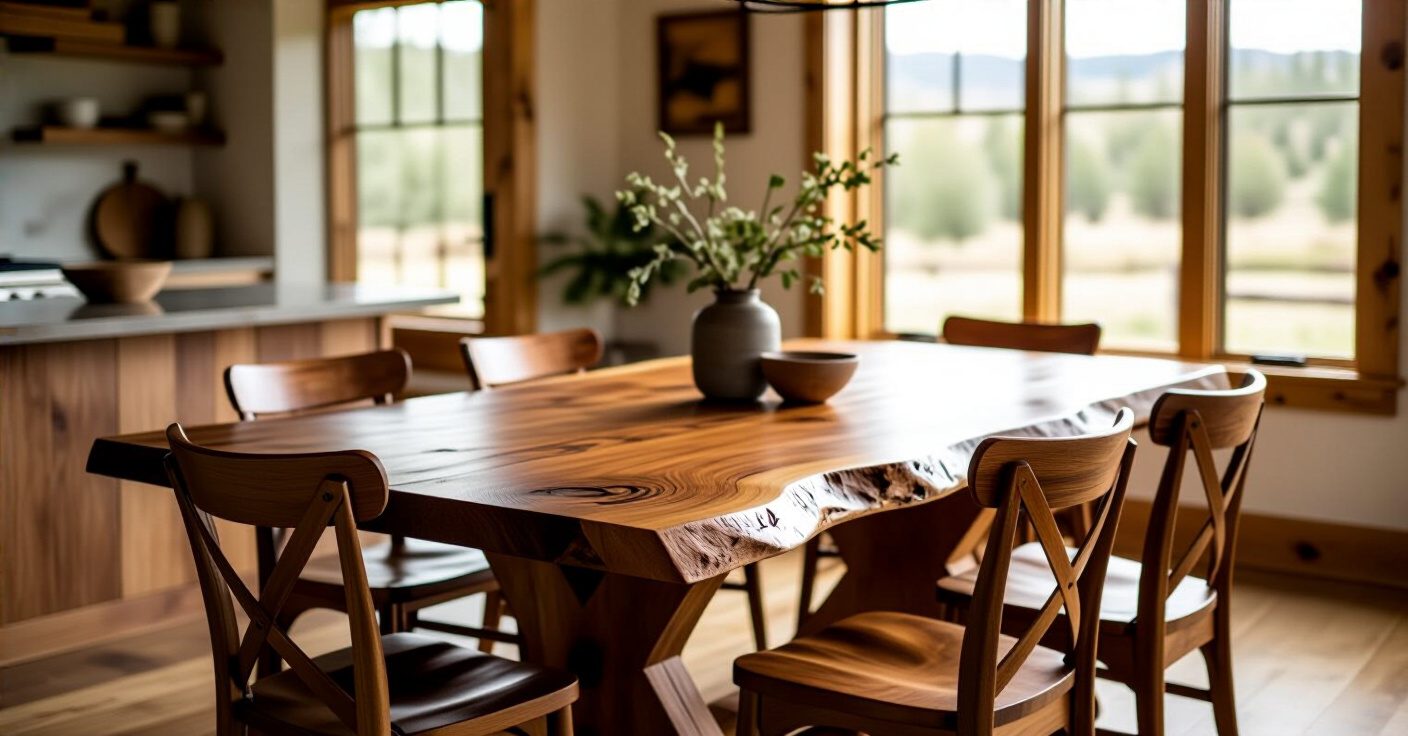
Learn how to design an authentic rustic dining room with these 20 essential ideas from an architectural expert.
Picture this: You’re standing in a dining room. The air smells faintly of beeswax and old wood. A massive timber beam runs overhead, dark and hand-hewn, telling a story a century old. Your hand rests on the back of a chair, solid and sturdy, not one of a matching set but a piece that feels like it was found, not just bought. This isn’t a showroom. It’s a space with a soul, a room that invites you to pull up a chair, pour a glass of wine, and stay a while.
That’s the essence of a truly rustic dining room. It’s not a trend you can buy in a box. It’s a feeling you build, layer by layer, with materials that have character and objects that have history. People get so hung up on matching everything perfectly, but that’s the fastest way to create a room with no personality. Forget perfection. We’re going for authenticity, for warmth, for a space that feels like it’s been the heart of a home for generations, even if you just finished it last week. Here’s how you actually get there.
Before you buy a single chair or plate, we have to talk about the bones of the room. These are the big-picture choices that create the canvas. Get these right, and everything else will fall into place with a beautiful, natural logic.
You know what drives me crazy? When I see a beautiful piece of oak or pine entombed in a thick, glossy, plastic-like varnish. It kills the wood. You might as well have bought particleboard. The entire point of rustic design is to celebrate the honesty of natural materials, and that starts with letting wood actually look and feel like wood. The grain, the knots, the slight variations in color—that’s the story of the tree it came from. Don’t silence it.
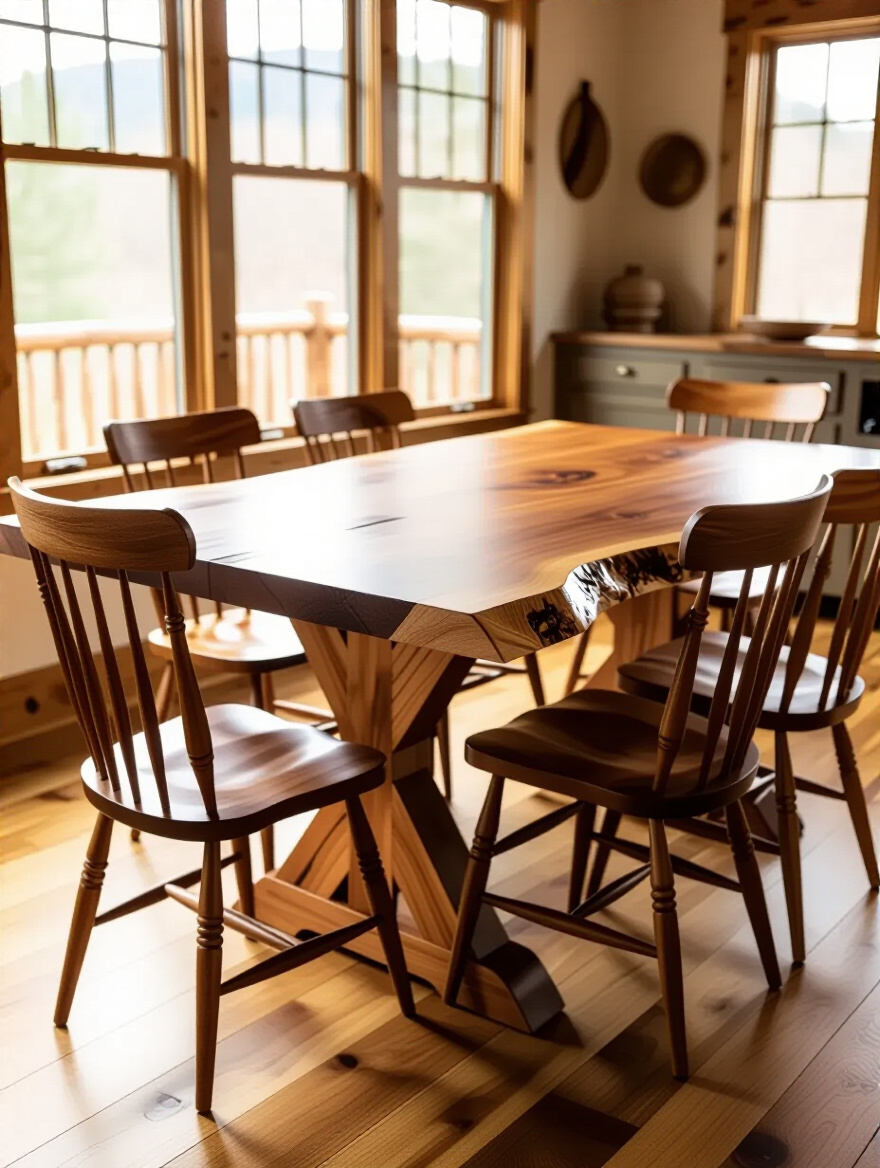
When you’re looking at tables, sideboards, or chairs, run your hand over the surface. Can you feel the texture, however subtle? Does the finish have a soft sheen rather than a hard glare? Choose finishes like natural oils (tung or linseed are fantastic), wax, or a simple matte clear coat. These protect the wood while letting it breathe and age gracefully. I had a client who was about to toss her grandmother’s dull-looking maple sideboard. We spent a weekend stripping off the grimy old varnish and refinishing it with a simple wax. It came alive. The piece didn’t just look better; it felt like it had been given back its voice.
Now, let’s talk about the single most important piece of furniture you’ll choose.
The farmhouse table is the undisputed king of the rustic dining room. It’s not just a place to eat; it’s the operational headquarters for family life. It’s where homework gets done, holiday meals are served, and late-night conversations unfold. Its defining feature is substance. We’re talking thick legs, solid construction, and a generous top that isn’t afraid of a few dings and scratches. Those marks become part of its history, a patina of memories.
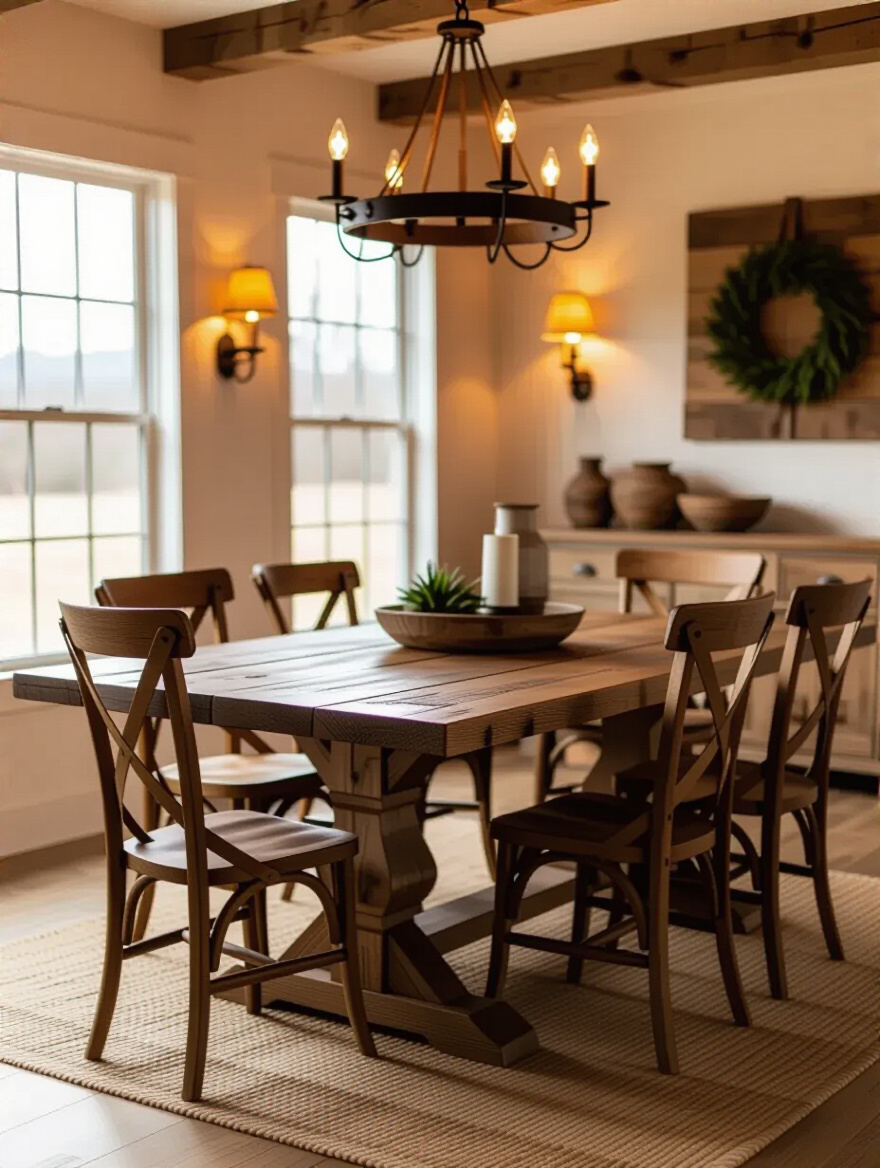
Forget flimsy tables with skinny legs. A proper farmhouse table should feel like it could survive a brawl. When you’re shopping, give it a good shake. Does it wobble? If so, walk away. Look for sturdy construction, like trestle bases or thick, turned legs. Reclaimed wood is fantastic here because it comes with built-in character, but a new, well-made pine or oak table will develop its own personality over time. The key is to make it the gravitational center of the room—a piece so solid and inviting that everyone is naturally drawn to it.
Once the table is set, we need to think about the architectural shell that surrounds it.
If you’re lucky enough to have an old house, the most authentic rustic feature might be hiding right above your head. Before you do anything else, look up. See if you can expose the original structural beams. Peeling back plaster to reveal hand-hewn timbers is like finding treasure. It instantly grounds the room in history and craftsmanship. Those adze marks and pegged joints tell a story about how the house was built, and no decorative addition can ever replicate that.
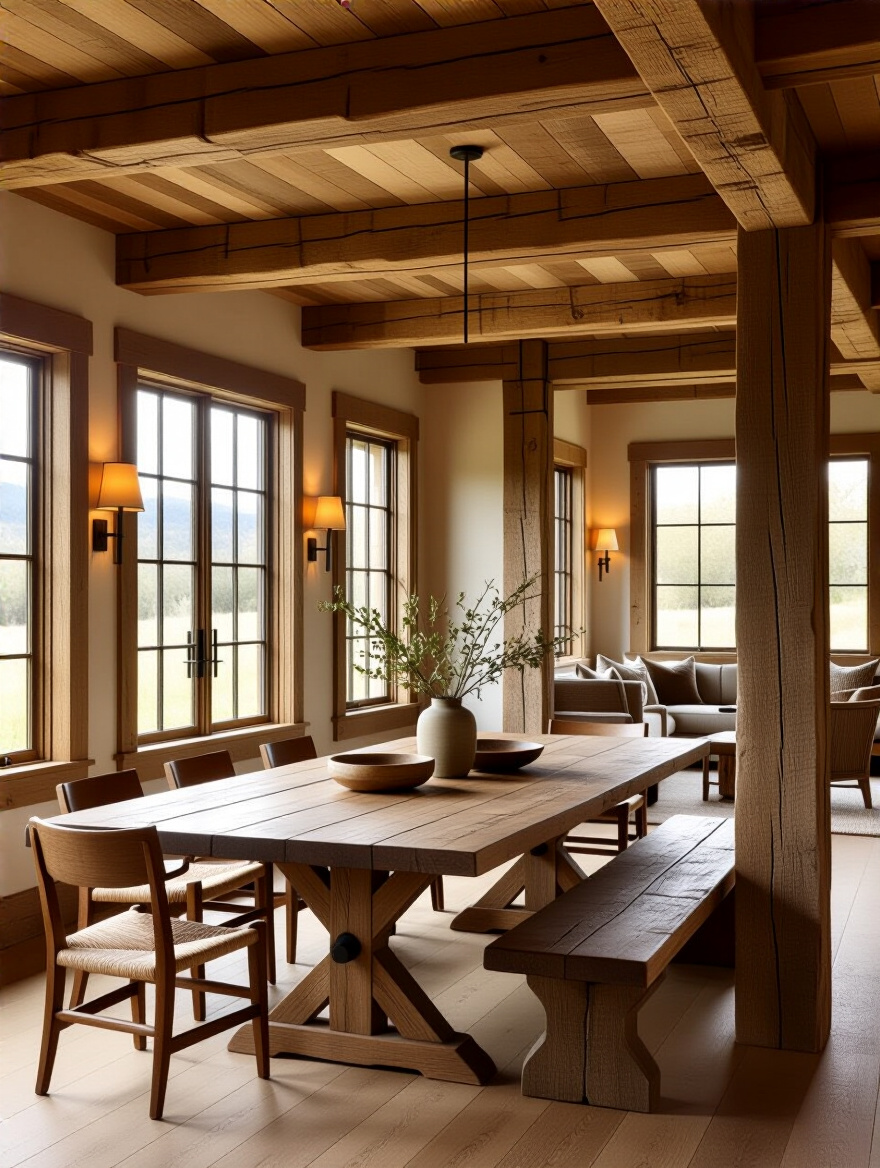
If your home is newer and doesn’t have original beams to expose, you can add them, but for the love of all that is sacred, do it thoughtfully. Faux beams made of foam are a sin. Use solid or reclaimed wood. An accent wall of reclaimed barn wood can also work wonders, adding texture and warmth that drywall just can’t touch. Just don’t overdo it. A common mistake is to panel every wall, which can make the room feel like a dark, oppressive crate. The goal is to add an architectural whisper of the past, not shout it from every surface.
With these strong architectural elements in play, your wall color becomes a crucial supporting actor.
Everyone hears “neutral” and thinks “boring.” But in a rustic space, the walls are not the main event. The wood, stone, and metal are the stars. The paint is there to make them look good. A warm, neutral palette—think creamy whites, soft beiges, and muted, earthy grays—creates a calm, cohesive backdrop that lets the texture of your materials shine. A stark, cool white will feel clinical and fight against the cozy vibe you’re trying to create.
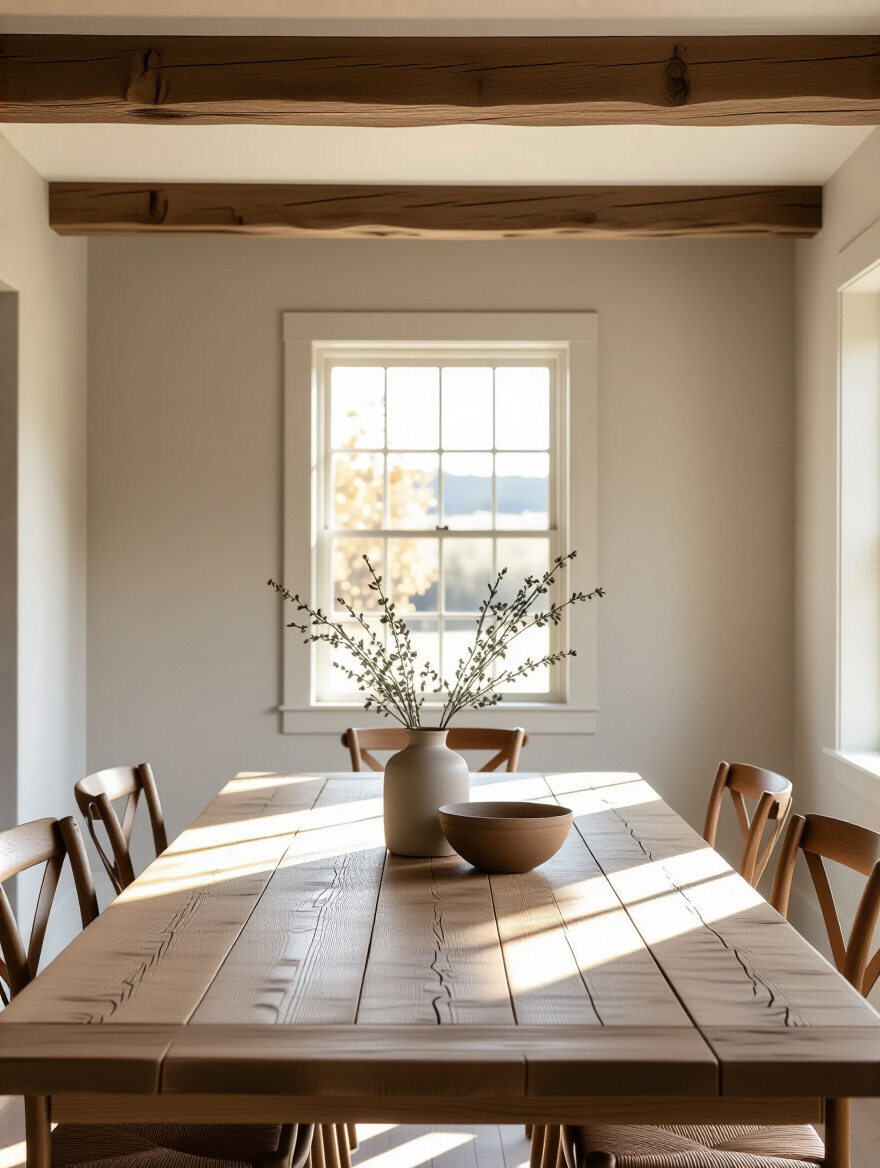
I learned this the hard way on an early project. We’d exposed beautiful old brick, but the client insisted on a brilliant white paint for the other walls. The contrast was so jarring it felt like an art gallery, not a home. We repainted with a soft, warm cream, and the whole room just exhaled. It felt instantly more comfortable. Test your paint swatches on the wall and look at them at different times of day. Find a color that has a warm, earthy undertone that complements the wood and stone in your room, rather than competing with it.
Now that the room has its backdrop, let’s think about how it connects to the rest of the house.
The traditional dining room was a formal, closed-off box. But modern life—and the rustic ethos—is more about communal, casual gathering. An open-concept layout that connects the dining area to the kitchen or living room can be a wonderful way to foster that sense of togetherness. The cook is no longer isolated from the party, and conversation can flow freely between spaces. It turns the act of dining into part of a larger, more social experience.
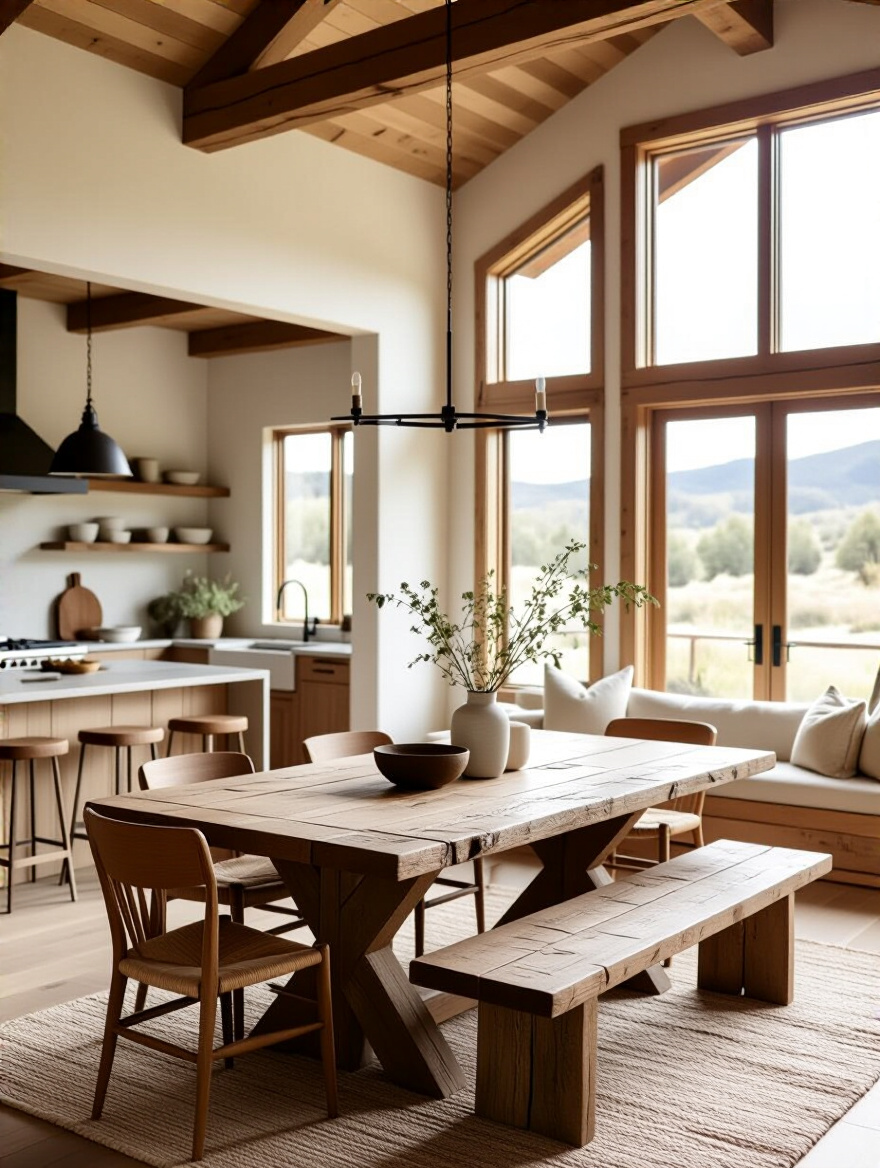
The big mistake people make with open-concept is creating a giant, undifferentiated cavern where the furniture feels like it’s lost at sea. You have to create defined “zones” without using walls. Your big farmhouse table and a statement light fixture above it immediately define the dining zone. A large area rug under the table and chairs is another non-negotiable—it acts like an island, anchoring the dining set and visually separating it from the living area or kitchen workspace. It maintains the open, airy feeling while giving each area its own clear purpose and place.
With the room’s overall structure and flow established, it’s time to furnish it with pieces that have character.
This is where you layer in the personality. We’re moving beyond the big architectural strokes and choosing the pieces that you will interact with every day. Each one is an opportunity to add to the room’s story.
Please, I beg you, step away from the matching 7-piece dining set. Nothing says “I have no imagination” faster than a perfectly uniform set of chairs. A collected, mismatched approach is the soul of rustic charm. It suggests that the pieces were gathered over time, each with its own story. It instantly makes a room feel more personal, lived-in, and interesting.
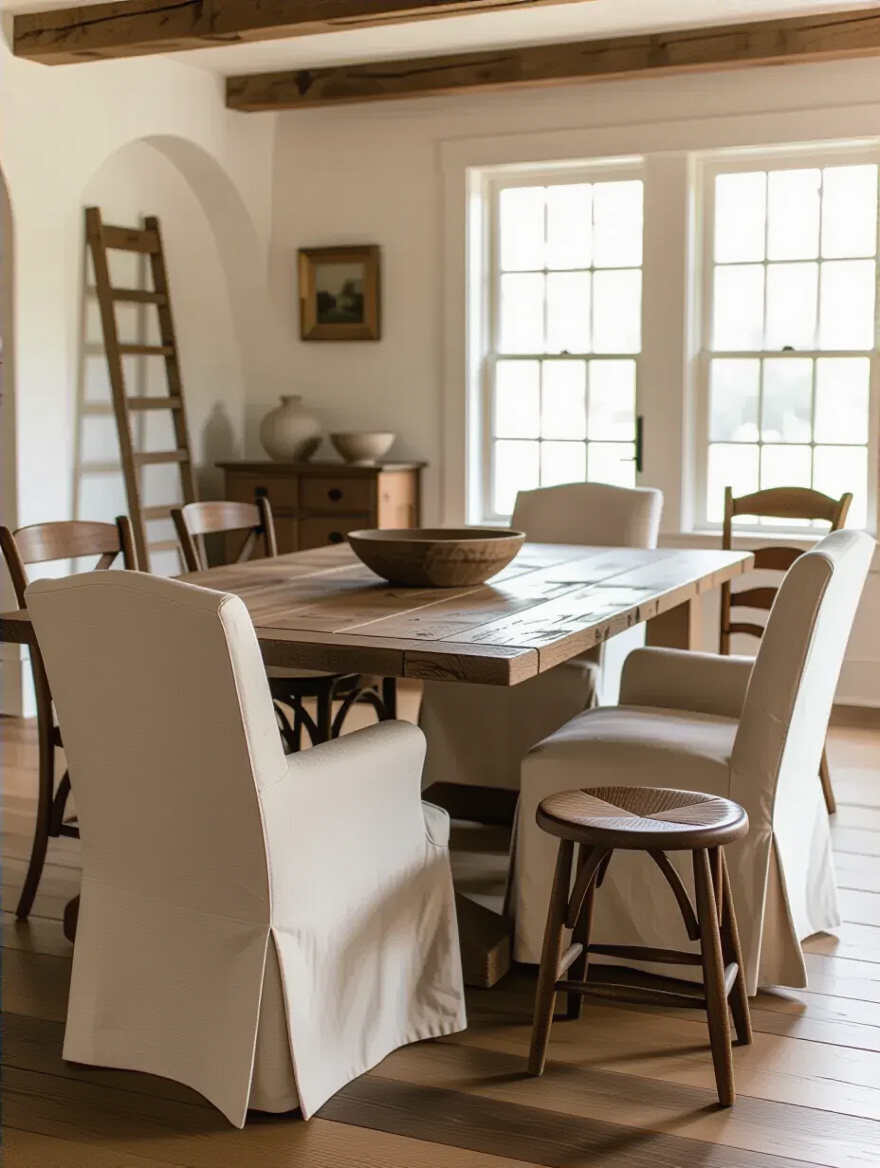
The trick is to make it look intentionally curated, not like you just grabbed whatever was on the curb. You need a unifying thread. It could be material (all wooden chairs, but different styles), or color (different styles of chairs all painted the same shade of creamy white or black), or era (all vintage farmhouse chairs). My favorite combination is a long bench on one side, two more substantial host chairs at the ends, and a few different (but complementary) side chairs on the other. It’s a formula that provides visual interest, flexibility, and a ton of charm.
Now that people have a place to sit, you need a place to put all the stuff that goes with dining.
A rustic dining room has to be practical, and a good sideboard or buffet is a workhorse. It’s your storage for dishes, linens, and serving pieces, keeping clutter out of the kitchen. It’s also a serving station for holiday meals or a bar for parties. Aesthetically, it’s a critical anchor piece that balances the visual weight of your dining table.
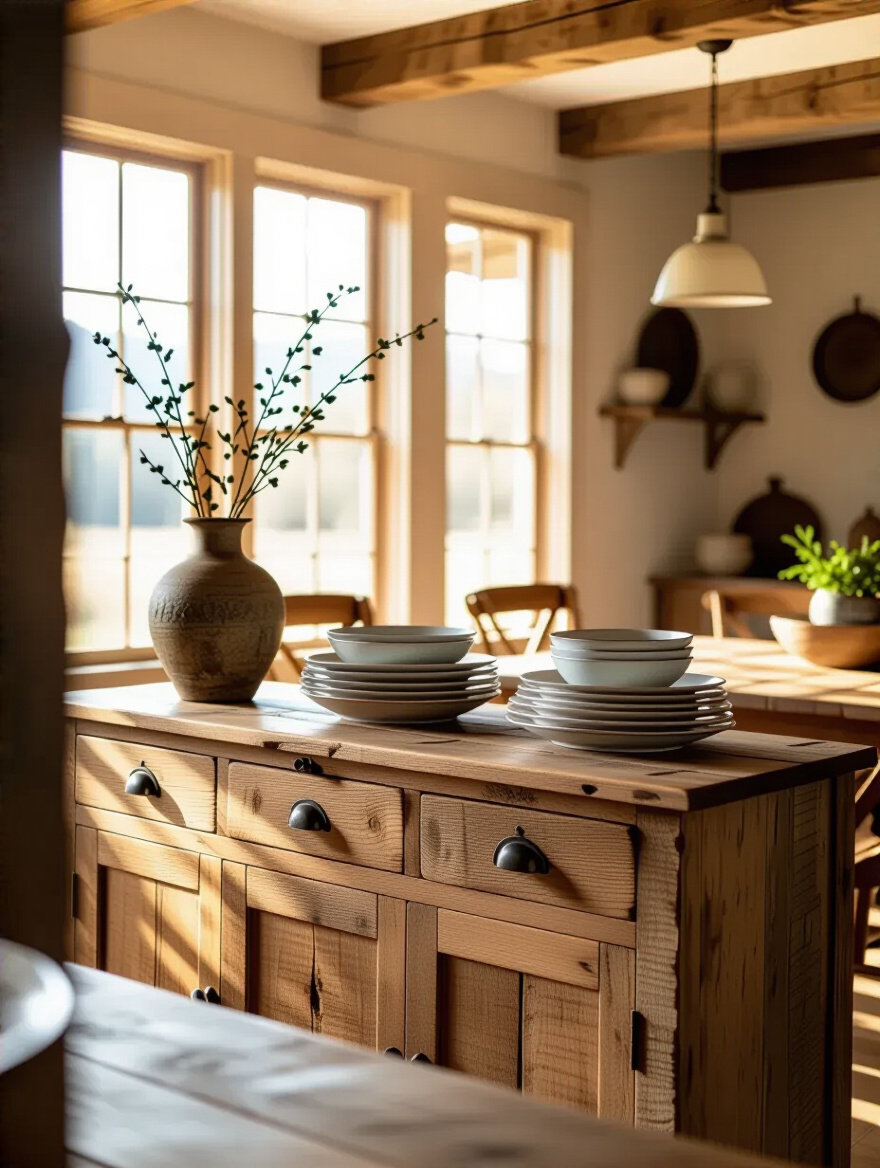
The key here is scale. A wimpy little sideboard next to a massive farmhouse table will look ridiculous. It needs to have presence. Look for pieces made from solid, reclaimed wood with simple, sturdy hardware like forged iron pulls or bronze knobs. A weathered or distressed finish is great, as long as it looks earned, not factory-faked. This is a piece that should feel as solid and timeless as your table, a quiet, dependable partner that grounds the design and makes the room more functional.
And for displaying your most cherished pieces, nothing beats a classic hutch.
While a sideboard offers concealed storage, a hutch or cabinet gives you a stage. This is where you display the pieces that tell your family’s story—Grandma’s ironstone pitchers, a collection of pottery from your travels, or your favorite old cookbooks. An antique hutch brings a sense of history and verticality to the room that is hard to achieve otherwise. Its age, patina, and craftsmanship are a testament to a time when things were built to last.
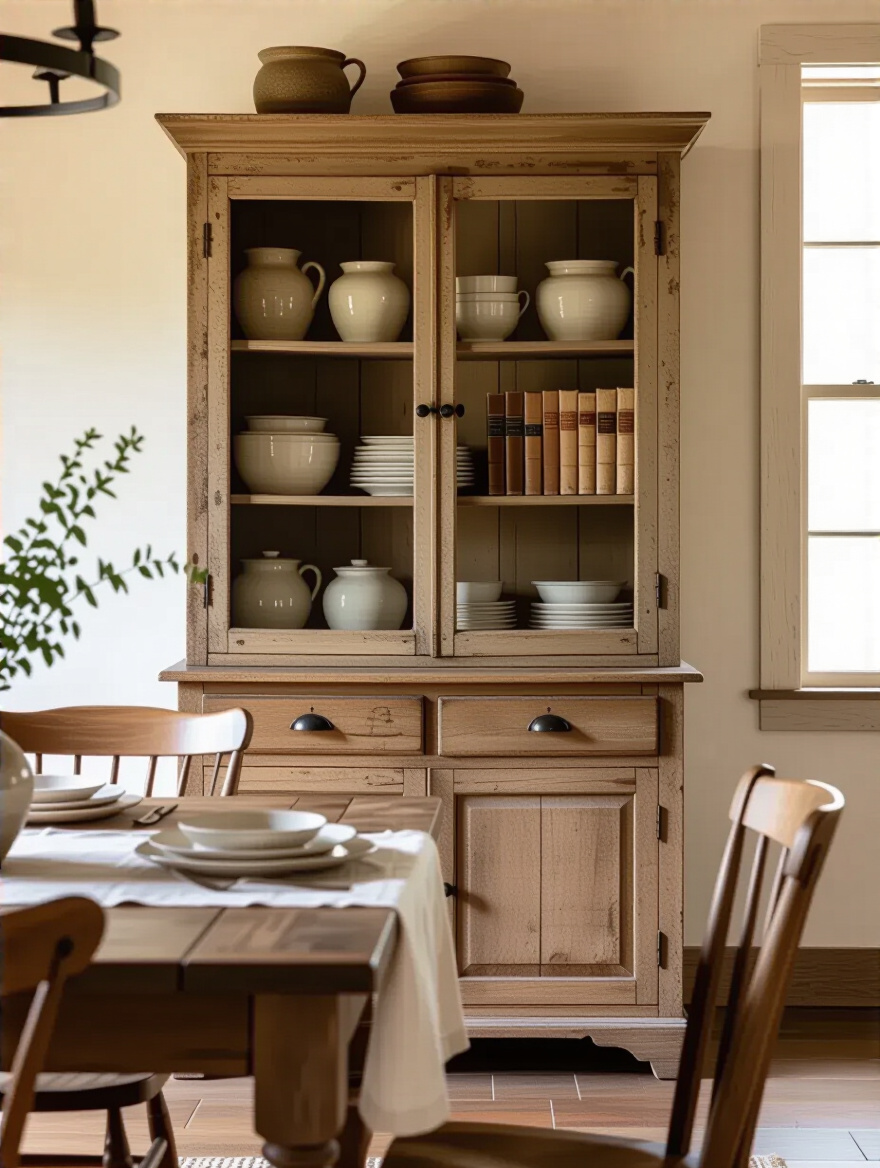
When you’re hunting for one, look for solid wood construction and signs of genuine age—dovetail joints in the drawers, slight imperfections in the glass, and hardware that shows years of use. Don’t be afraid of scratches or a slightly faded finish; that’s its character. The biggest mistake is over-stuffing the shelves. Give your pieces room to breathe. And here’s a shortcut I love: install some discreet LED strip lighting on the underside of the shelves. It turns your collection into a beautifully illuminated focal point in the evening, adding a warm, magical glow to the room.
To keep the seating options flexible and informal, consider this timeless choice.
A bench is one of the most versatile pieces you can have. It immediately signals a more casual, communal atmosphere, inviting people to squeeze in and sit close. From a practical standpoint, it’s a space-saver. You can tuck it completely under the table when it’s not in use, and it can often seat more people than the equivalent number of chairs. It’s perfect for families with kids or for anyone who loves hosting big, informal gatherings.
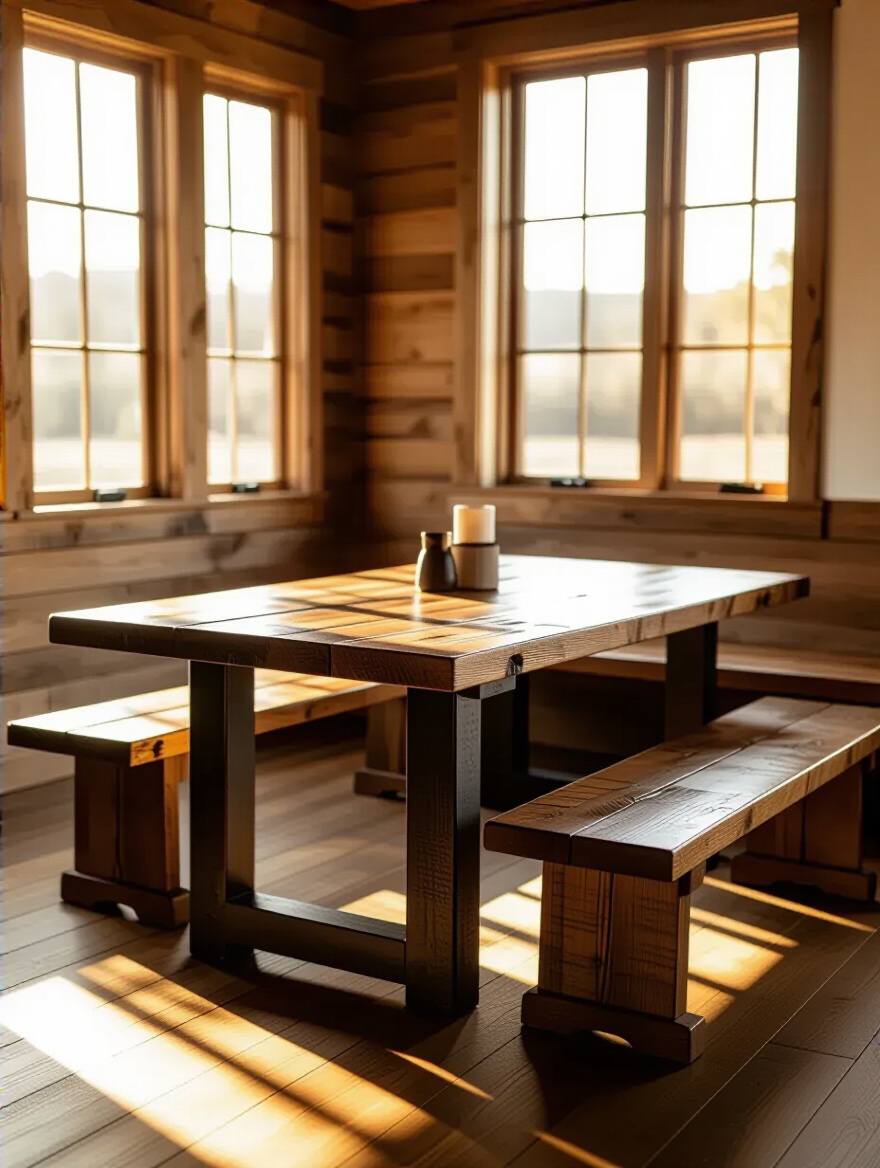
Look for a bench that is as sturdy as your table—no wobbles! Solid wood is a classic choice, and you can easily soften it with a custom cushion or a few sheepskin throws. Pairing a bench on one side of the table with individual chairs on the other is a classic designer trick. It gives you the best of both worlds: the relaxed, communal vibe of the bench and the individual comfort of the chairs. It breaks up the monotony and adds another layer of visual interest.
Now that the major furniture pieces are in place, we can start weaving in the sensory details that make a room truly inviting.
This is the fun part. The furniture provides the structure, but texture is what gives a rustic room its soul. It’s about creating a space that is a delight to all the senses, a room that makes you want to touch everything.
A dining room full of hard surfaces—wood, metal, stone—can feel a bit cold and austere, no matter how beautiful the materials are. The fastest and easiest way to counteract that is by layering in soft, inviting textiles. Think of a chunky knit wool throw draped over the back of a host chair or a soft faux fur pelt tossed casually on a bench. It’s an instant invitation to get comfortable.
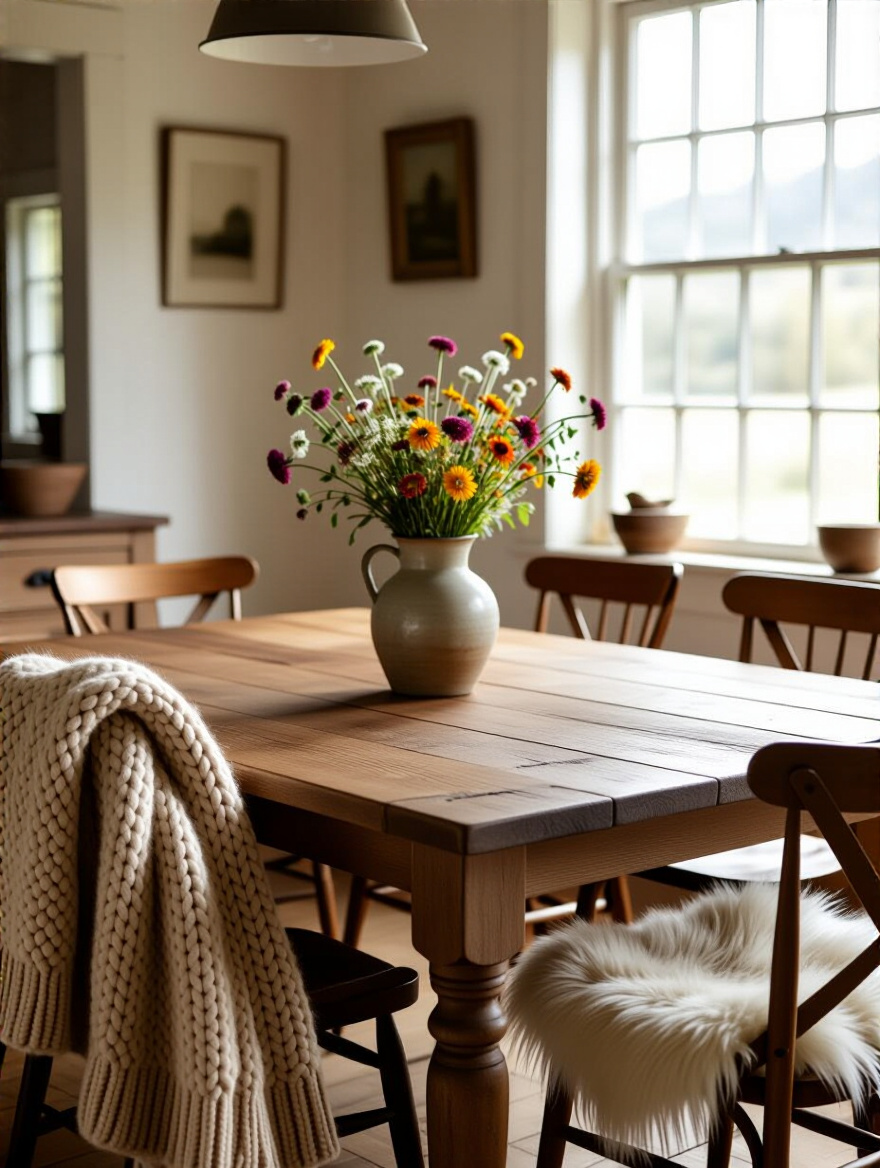
These textures do more than just add physical comfort; they add visual warmth and absorb sound, making the room feel quieter and more intimate. Don’t go overboard—a few well-placed pieces are all you need. Stick to a neutral palette of creams, grays, and oatmeal to complement the natural materials. The goal is to create a pleasing contrast between hard and soft, smooth and rough, which is what gives a rustic space its rich, layered feel.
Next, we’ll introduce a different kind of texture with some hard-working materials.
Just as soft textiles balance the hardness of wood, metal accents provide a crucial counterpoint to all the natural, organic elements. Wrought iron, with its dark, matte finish, connects to a long history of blacksmithing and craftsmanship. It looks fantastic in light fixtures, curtain rods, or as the base of a table. It adds a touch of industrial grit that keeps the room from feeling too “country cute.”
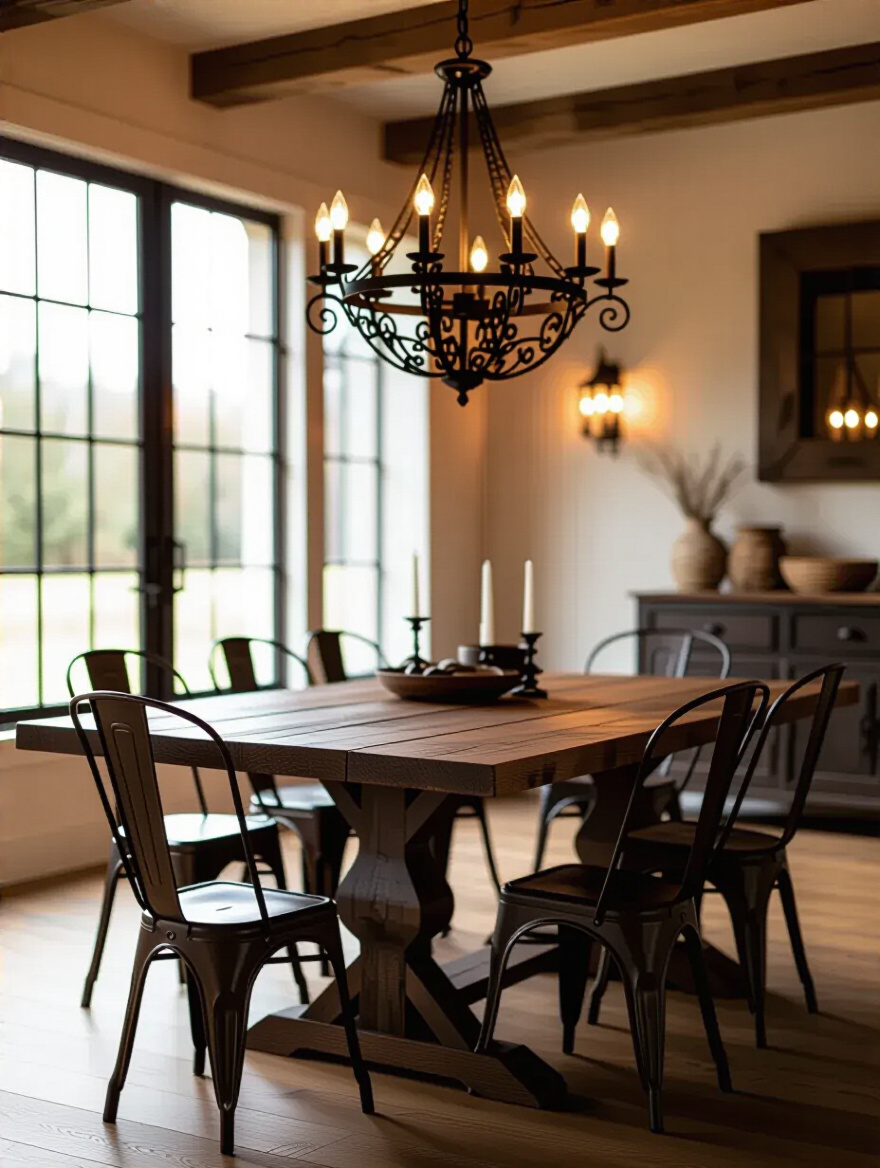
Copper is another wonderful choice. Its warm, rosy gleam adds a touch of sophistication and reflects light beautifully. I love seeing it in a hammered copper sink in an adjacent bar area or in a collection of vintage copper molds hanging on a wall. The best part about these metals is that they get better with age. Don’t polish your copper to a high shine; let it develop a rich, complex patina. That aged character is precisely what you’re looking for.
To continue building that sense of age, let’s focus on smaller, storied objects.
Here’s where you need to be careful. There’s a world of difference between an object that has a genuine, time-worn patina and a new item that’s been artificially “distressed” in a factory. One tells a story; the other is a lie. Seek out the real thing. Hunt through flea markets, antique shops, and salvage yards for objects that have lived a life.
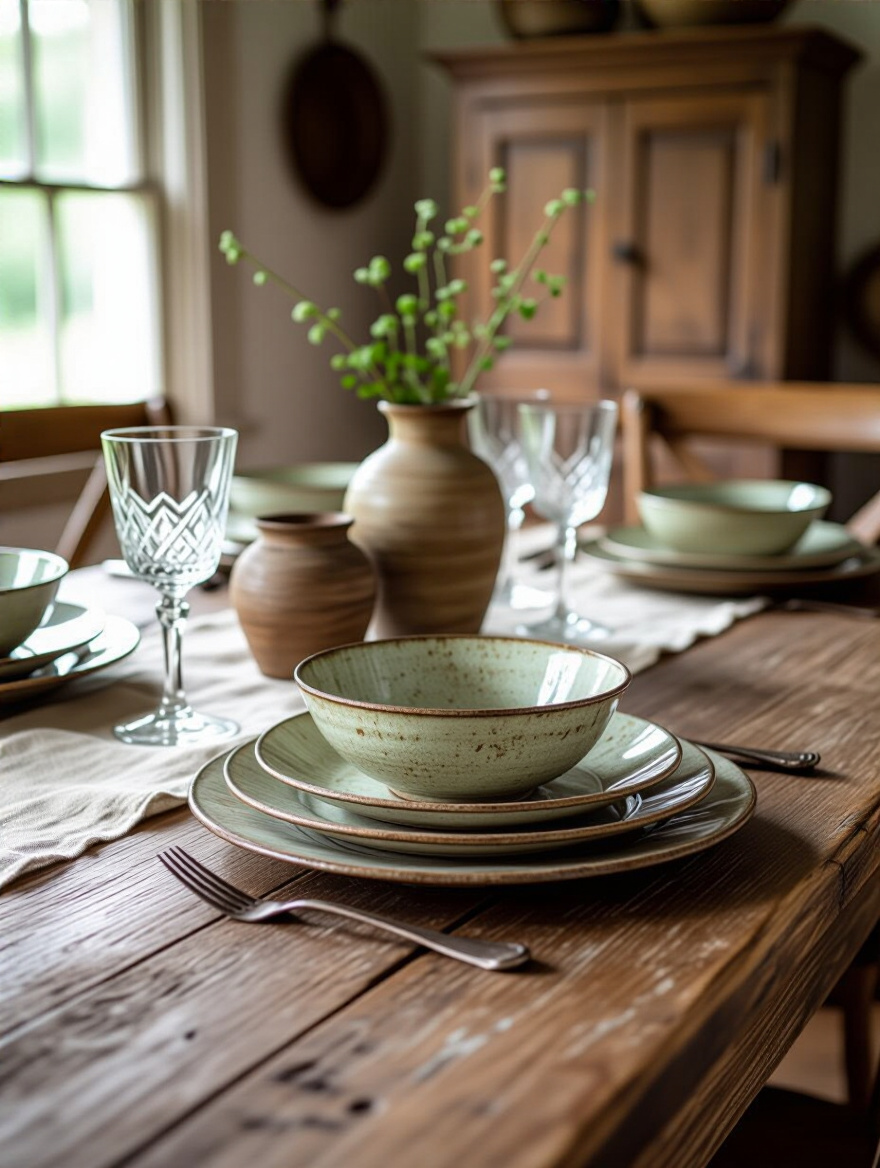
Think about a primitive wooden dough bowl used as a centerpiece, its surface smoothed and scarred from years of use. Or a collection of old stoneware crocks with slight crazing in the glaze, or a rusty old metal sign. These aren’t just decorations; they are artifacts that bring a palpable sense of history and soul into your home. The key is to curate, not clutter. A few carefully chosen pieces with real character will have far more impact than a room full of fakes.
Now, let’s anchor all of this with a crucial element on the floor.
I cannot stress this enough: you need a rug under your dining table. In any room, but especially in an open-concept space, a rug defines the dining area and keeps your furniture from looking like it’s floating. For a rustic aesthetic, natural fiber rugs like jute, sisal, or seagrass are the perfect choice. Their earthy, woven texture is the ideal complement to wood and stone, and they are incredibly durable.
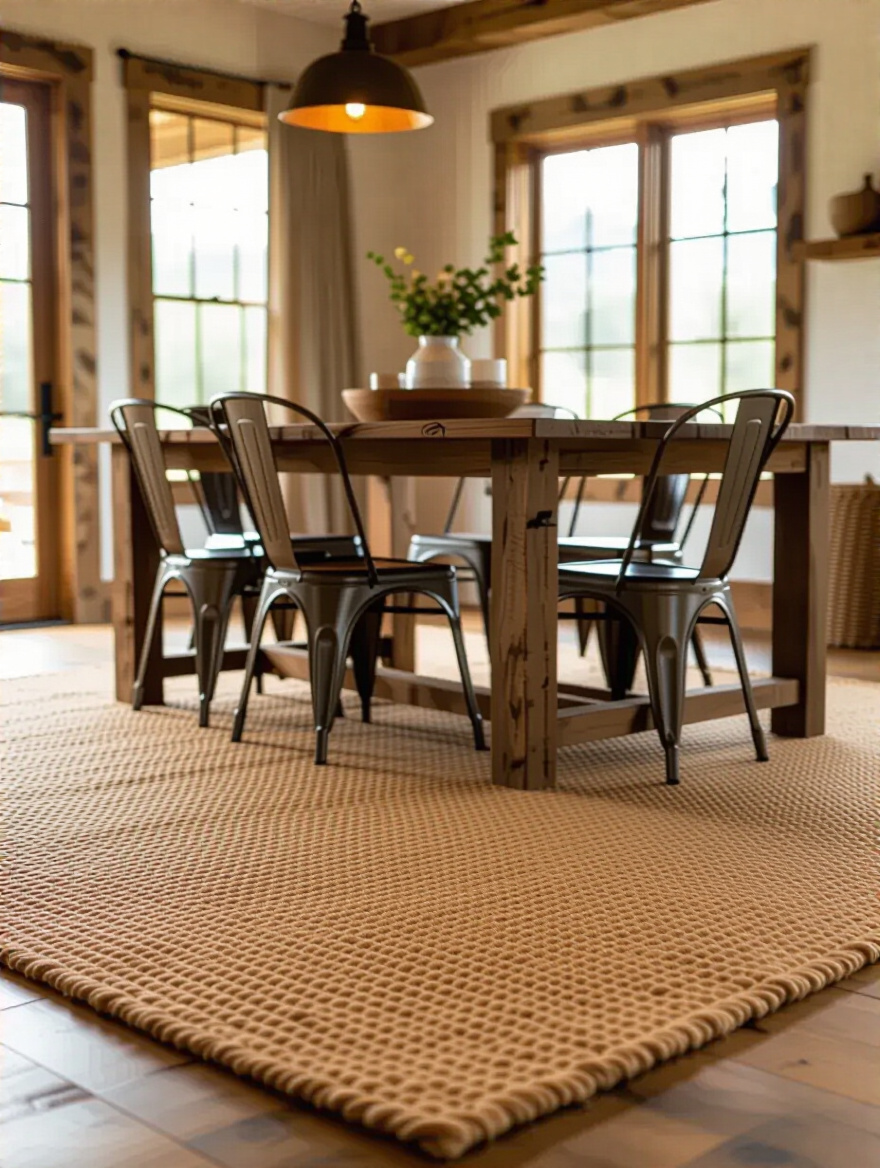
The single biggest mistake people make is buying a rug that’s too small. You should be able to pull the chairs all the way out from the table and still have all four legs on the rug. The rule of thumb is to measure your table and add at least 24 inches on all sides. A properly sized rug will make the whole room feel more grounded, cohesive, and intentional. It also adds another layer of texture and warmth and helps absorb sound, which is a big bonus in a lively dining space.
From the floor, we’ll now turn our attention back to the walls to add even more texture.
If exposed beams are the soul of the ceiling, stone or brick are the soul of the walls. Nothing adds a sense of permanence, warmth, and texture quite like them. If you’re lucky enough to have an original stone fireplace or a brick wall in your home, celebrate it! Clean it up, re-point it if necessary, and let it be the star of the show. It’s an architectural feature that’s impossible to fake convincingly.
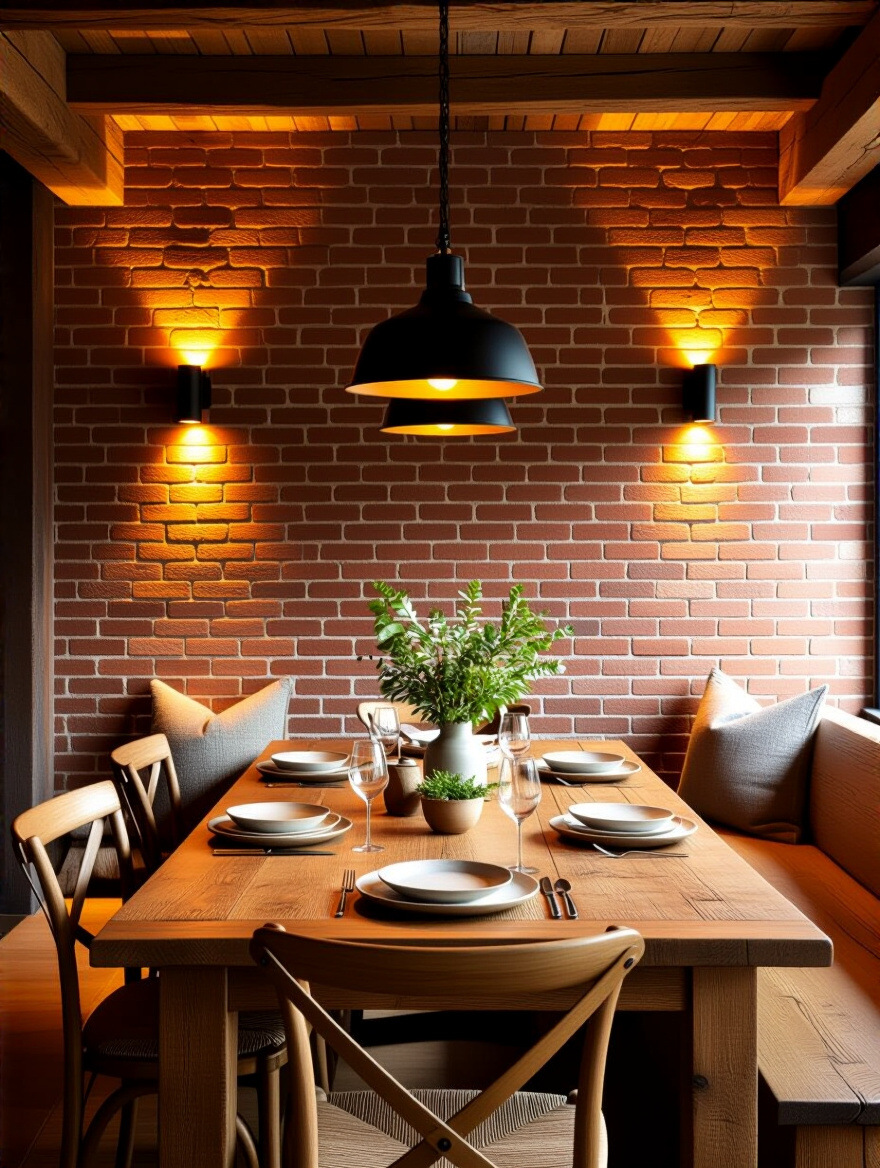
If you don’t have the real thing, a high-quality, thin-cut stone or brick veneer can be a great alternative, especially for a fireplace surround or an accent wall behind a sideboard. Just make sure the installation is impeccable. A pro tip I love is to “graze” the wall with light. Install spotlights in the ceiling or uplights on the floor a few inches away from the wall. This will cast dramatic shadows across the surface, highlighting the incredible texture and making the material come alive.
With the physical elements in place, it’s all about creating the right mood.
You can have the most beautiful furniture and textures in the world, but if your lighting is bad, your room will fall flat. Lighting is everything. It sets the mood, highlights your favorite features, and makes the space functional.
Your main light fixture over the dining table has to do two jobs: provide enough light for eating and activities, and make a strong style statement. This is the perfect place for a dramatic wrought iron chandelier or a linear fixture with an industrial vibe. The dark, robust metal provides a fantastic contrast to the wood and textiles in the room and serves as a powerful focal point.
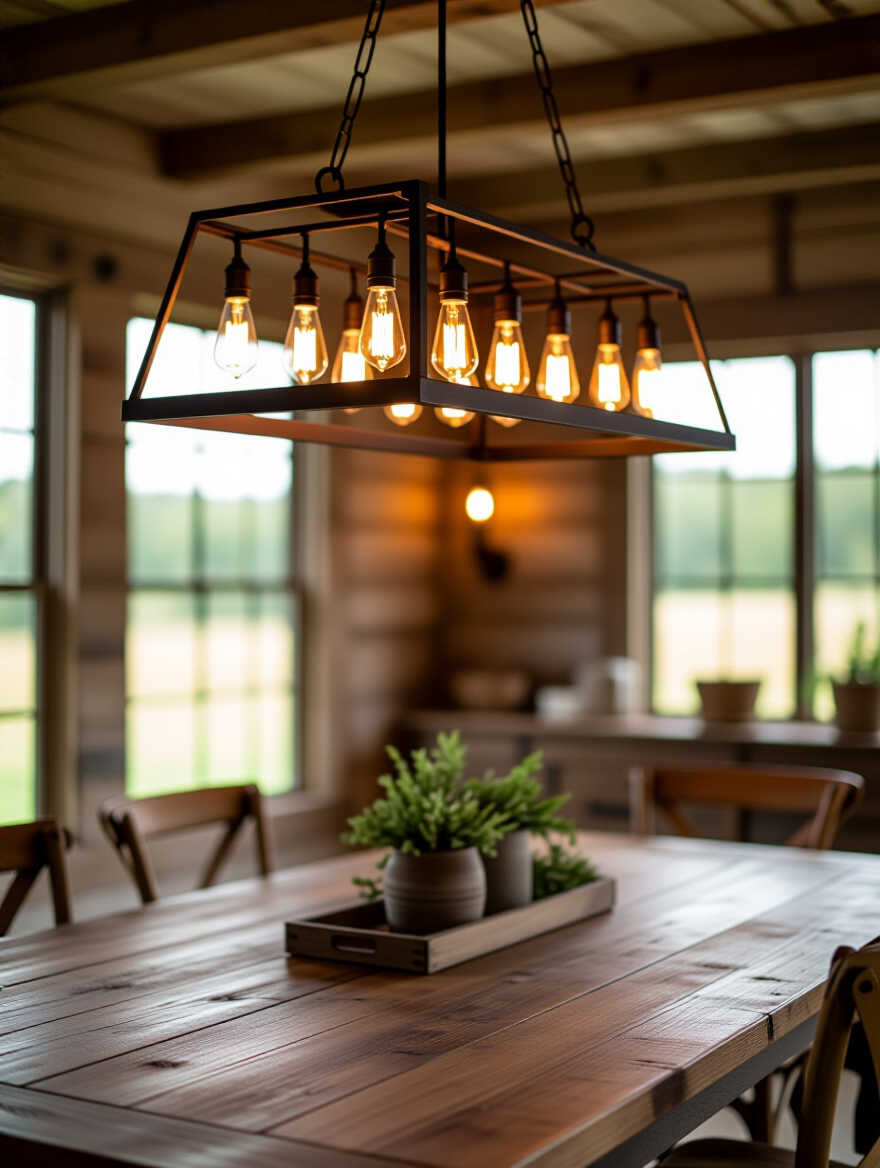
Look for fixtures with simple, strong lines. Exposed Edison-style bulbs are a great fit for this look, as they cast a warm, vintage-style glow. But whatever you choose, for the love of God, put it on a dimmer switch. You need bright light for cleanup or a family board game, but for an intimate dinner party, you want to be able to bring the light down to a soft, flattering glow. Without that control, you’ve lost half the battle.
To complement your main fixture, you need to manage the natural light in the room.
Direct, harsh sunlight can be brutal in a dining room, creating glare and making people uncomfortable. You want to filter that light, not block it. Sheer or semi-sheer curtains made from natural fibers like linen or cotton are the perfect solution. They diffuse the incoming light, casting a soft, warm glow throughout the space while still keeping it bright and airy.
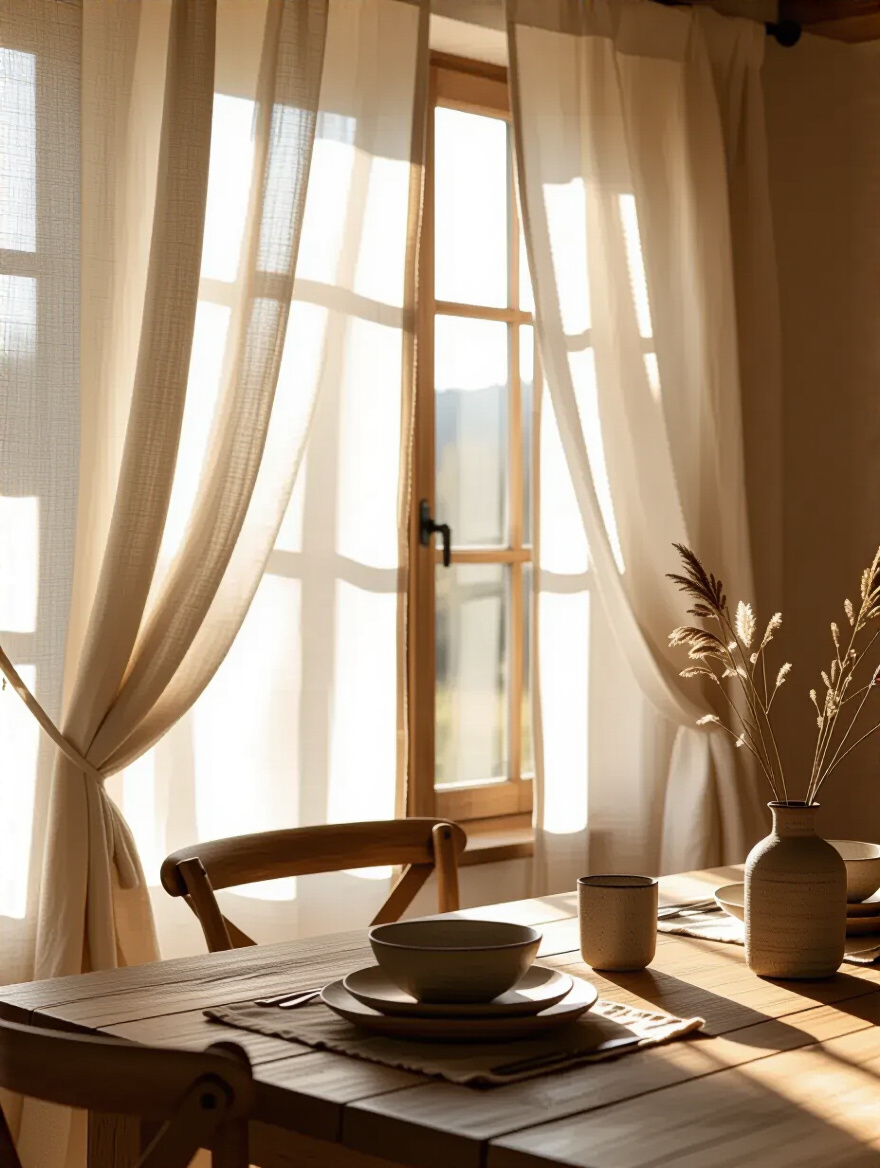
The beauty of linen, in particular, is its imperfection. It has a natural, slightly rumpled texture that is the epitome of relaxed, rustic elegance. Don’t fight it by trying to iron it into submission. Let it hang in its natural, graceful drape. Stick to light, neutral colors like white, ivory, or natural flax to maximize the light and maintain a serene, calming atmosphere. They soften the hard edges of the windows and add another layer of beautiful, tactile texture to the room.
And this next tip is the single most important one for creating atmosphere.
If you do only one thing from this entire list, do this. Install dimmer switches on every single light in your dining room. It is the cheapest, highest-impact upgrade you can possibly make. It gives you complete control over the mood of the room, allowing you to transform it from a bright, functional space to a cozy, intimate retreat at the touch of a dial.
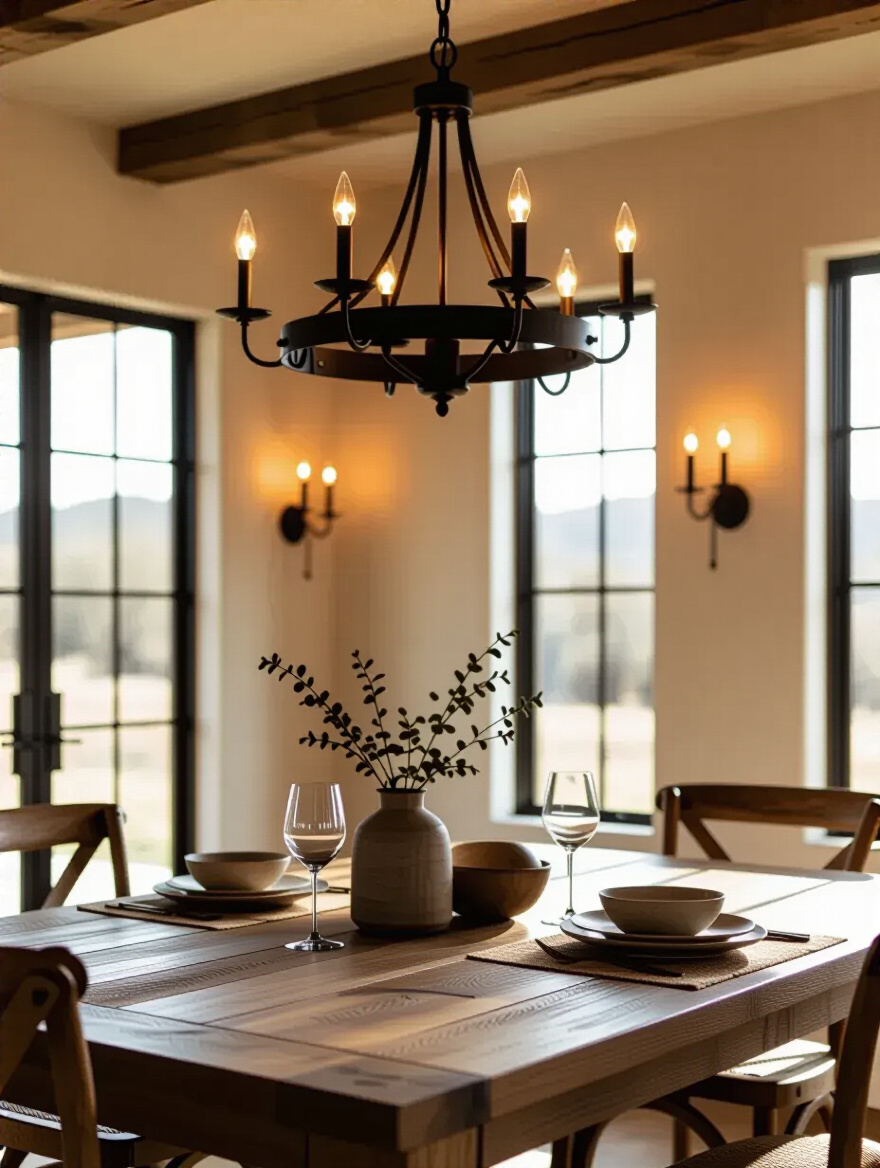
Think about it: you want full brightness for homework, about 75% for a lively family dinner, and maybe 30% for a romantic meal or quiet after-dinner drinks. Having a single on/off switch is like having a car with only one speed. It’s a completely blunt instrument. Layer your lighting—the main chandelier, any wall sconces, and recessed lights—and put each on its own dimmer. This allows you to create sophisticated lighting “scenes” that make your room feel dynamic and professionally designed. It is, without a doubt, non-negotiable.
With the mood set, it’s time for the final, personal layers that make the space uniquely yours.
This is the last 10%. It’s the collection of details that truly brings your personality into the space and makes it feel like a curated, well-loved home, not just a decorated room.
Forget stiff, formal floral arrangements from a florist. A rustic dining room calls for something more natural and effortless. A handful of branches foraged from your backyard, a clutch of dried grasses like pampas or bunny tails, or a simple bundle of eucalyptus can make a stunning, sculptural statement. They bring a piece of the outdoors in, connecting your home to the landscape around it.
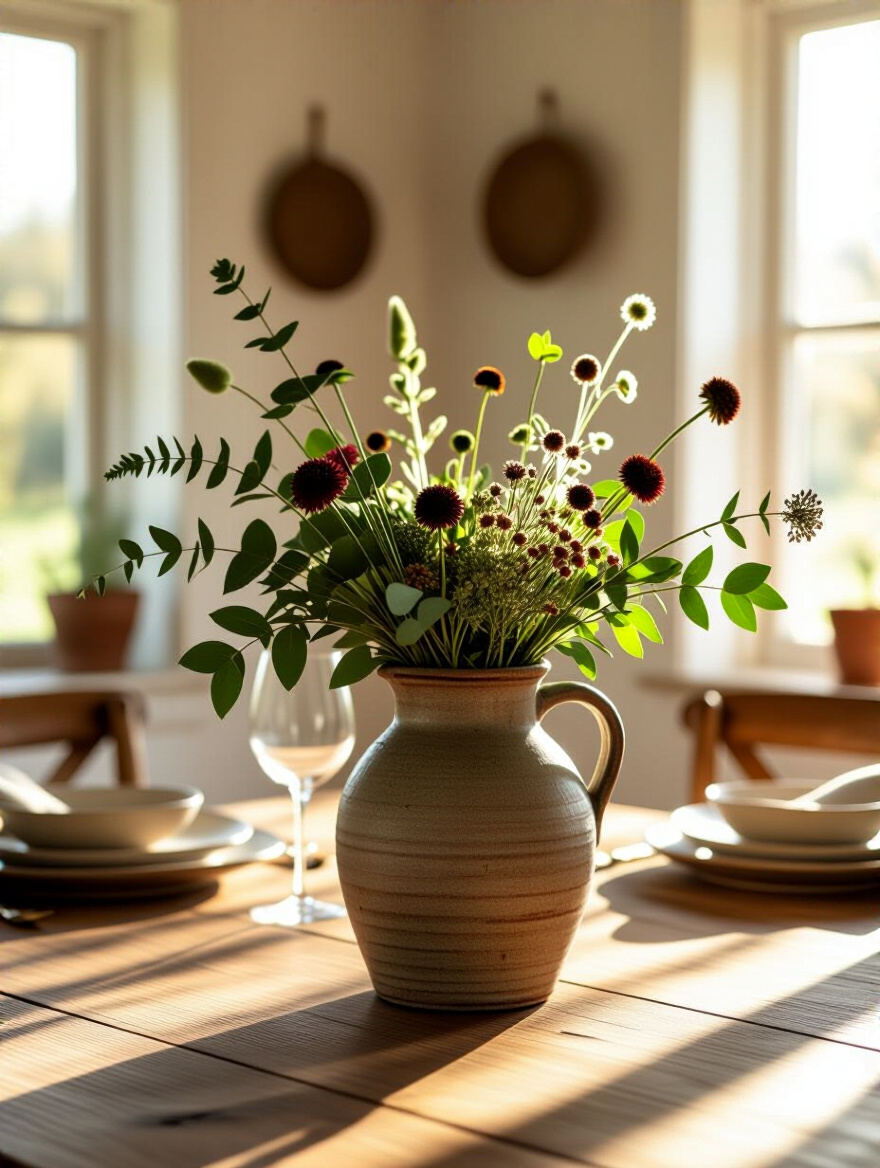
The beauty of dried or foraged arrangements is their longevity and their imperfect, organic character. Place them in a simple, earthy vessel like a stoneware jug, an old glass bottle, or a terracotta pot. I love a long, low arrangement running down the center of the table or a tall, dramatic branch in a large vase on a sideboard. It’s a sustainable, inexpensive way to add life, texture, and natural beauty to your room all year round.
To complement these natural elements, celebrate the work of human hands.
Just as you should seek out furniture with a story, your dishes and glassware can also be opportunities to celebrate craftsmanship. Swap out mass-produced, identical sets for unique, handcrafted pieces. Display a collection of artisanal pottery with earthy glazes and organic shapes on an open shelf or in a hutch. The subtle variations in each piece tell the story of the potter who made it.
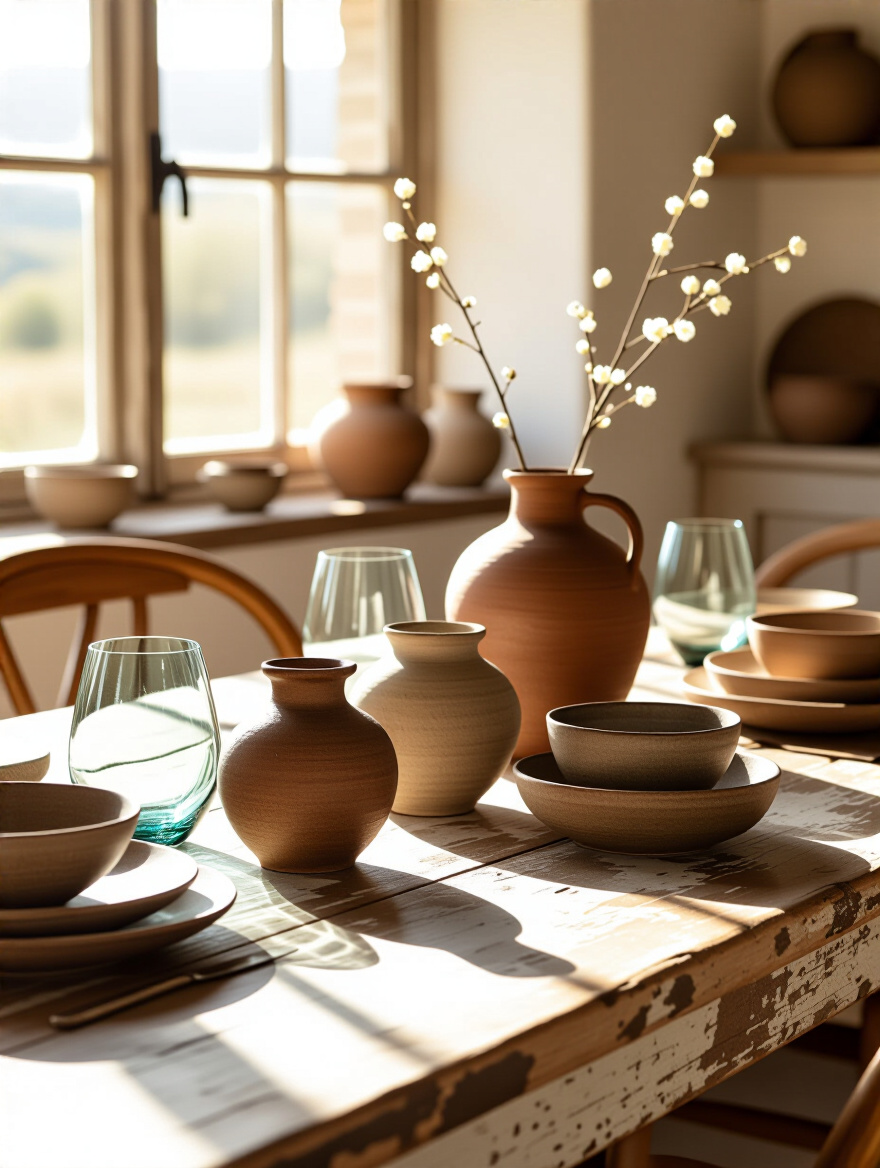
The same goes for glassware. Hand-blown glasses often have a slight weightiness and tiny imperfections that give them a character you’ll never find in a factory-made product. Displaying these items isn’t about showing off; it’s about surrounding yourself with objects that have soul and integrity. It elevates the simple act of setting the table into a richer, more tactile experience. Just remember to curate your display—a few special pieces will have more impact than a cluttered shelf.
Finally, we turn to the walls to tell the final chapter of your story.
Art is the most personal element in any room. In a rustic space, vintage maps and simple farmhouse-style prints are a natural fit. A large, beautifully framed antique map can be a stunning focal point, grounding the room and sparking conversation. Choose a map of a place that is meaningful to you—your home state, a favorite travel destination, or the land of your ancestors.
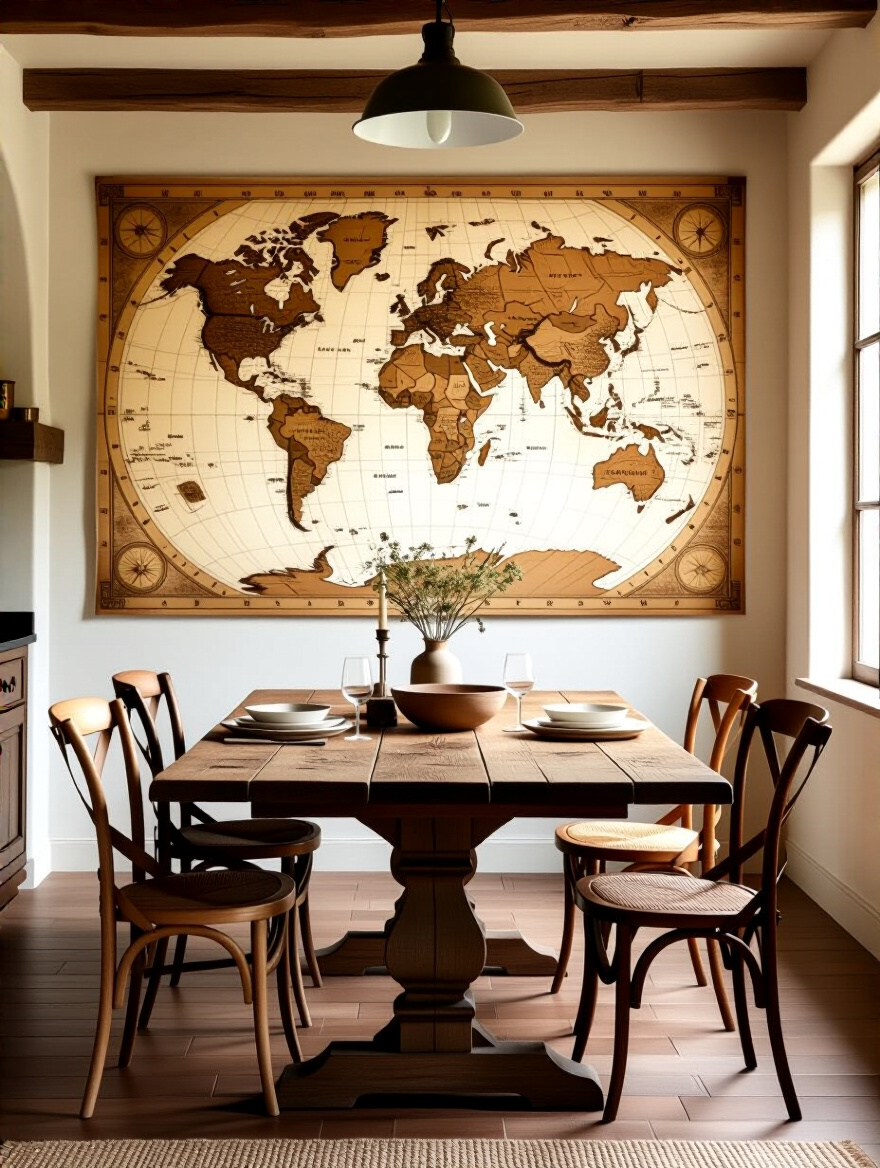
Farmhouse art, like botanical illustrations, simple landscape paintings, or animal sketches, adds a touch of nostalgic, bucolic charm. The key to making it all work is the framing. Opt for simple, rustic frames made from distressed or reclaimed wood or aged metal. And don’t feel like you have to fill every inch of wall space. Creating a single, impactful gallery wall or hanging one large, significant piece is far more effective than dotting small pictures all around the room. It’s your chance to put your story on the wall.
At the end of the day, creating a rustic dining room isn’t about following a rigid set of rules or buying a specific list of items. It’s a philosophy. It’s about choosing honesty over perfection, character over polish, and warmth over formality. It’s about building a space, layer by layer, that feels like a real home—a place that embraces the beauty of natural materials, celebrates craftsmanship, and tells the story of the people who live there.
Don’t be intimidated. Start with one thing. Find a solid wood table that you love. Hunt for a few mismatched chairs at a flea market. Put your lights on a dimmer. Each small, intentional choice will move you closer to creating that inviting sanctuary you’re dreaming of. Embrace the dings, the imperfections, and the stories embedded in each piece, and you’ll craft a dining room with a soul, a true heart of your home where you and your loved ones will gather for years to come.